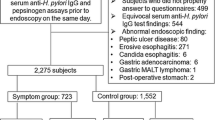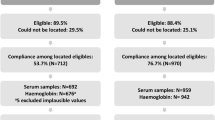Abstract
The significance of Helicobacter pylori (H. pylori) infection in pediatric abdominal pain remains poorly recognized. We examined associations of H. pylori infection and serum pepsinogens (PGs), as non-invasive markers of gastritis, with pediatric abdominal pain. A case-control study was conducted among 99 children aged 5–17 years admitted to one hospital for abdominal pain (cases) without an apparent organic reason. Using enzyme-linked immunosorbent assays, sera were tested and compared with 179 controls for anti-H. pylori immunoglobulin G (IgG) antibodies and PGI and PGII levels. Multivariable analysis was performed to adjust for potential confounders. H. pylori IgG sero-positivity was 34.3 and 36.3% in cases and controls, respectively, P = 0.7. H. pylori-infected children had higher median PGI and PGII levels and a lower PGI/PGII ratio than uninfected children. Cases infected with H. pylori had a higher median PGII level (P < 0.001) and lower PGI/PGII ratio (P = 0.036) than controls infected with H. pylori. The percentage of cases with PGII ≥7.5 μg/L, as indication for antral inflammation, was higher than in controls: 58.6 versus 44.7%, P = 0.027. Children with PGII levels ≥7.5 μg/L had increased risk for abdominal pain: adjusted prevalence ratio 1.73 [95% confidence intervals 1.02, 2.93], P = 0.039.
Conclusion: Children with increased serum PGII levels, as an indication of gastritis, are more likely to have abdominal pain. Serum PGs can be a useful non-invasive marker for gastritis, in evaluating children with severe abdominal pain with no apparent organic reason.
What is Known: • The significance of Helicobacter pylori infection in pediatric abdominal pain remains debated. • Serum pepsinogens (PGs), non-invasive markers of gastric inflammation, were rarely utilized in assessing the association between H. pylori in pediatric abdominal pain of unknown origin. |
What is New: • High serum PGII level, as an indication of gastritis, rather than H. pylori infection itself, was associated with increased risk for abdominal pain. • Serum PGs can be a useful biomarker for gastritis in evaluating children with severe abdominal pain with no apparent organic reason. |
Similar content being viewed by others
Abbreviations
- CagA:
-
Cytotoxin-associated gene A
- CI:
-
Confidence intervals
- ELISA:
-
Enzyme-linked immunosorbent assay
- IgG:
-
Immunoglobulin G
- IQR:
-
Interquartile range
- PG:
-
Pepsinogens
- PR:
-
Prevalence ratio
- SD:
-
Standard deviation
- RAP:
-
Recurrent abdominal pain
- VacA:
-
Vacuolating cytotoxin A
References
Benjamini Y, Hochberg Y (1995) Controlling the false discovery rate—a practical and powerful approach to multiple testing. J Roy Stat Soc B Met 57(1):289–300
Bode G, Brenner H, Adler G, Rothenbacher D (2003) Recurrent abdominal pain in children: evidence from a population-based study that social and familial factors play a major role but not Helicobacter pylori infection. J Psychosom Res 54(5):417–421
Chong SK, Lou Q, Asnicar MA, Zimmerman SE, Croffie JM, Lee CH, Fitzgerald JF (1995) Helicobacter pylori infection in recurrent abdominal pain in childhood: comparison of diagnostic tests and therapy. Pediatrics 96(2 Pt 1):211–215
de Angelis GL, Cavallaro LG, Maffini V, Moussa AM, Fornaroli F, Liatopoulou S, Bizzarri B, Merli R, Comparato G, Caruana P, Cavestro GM, Franze A, Di Mario F (2007) Usefulness of a serological panel test in the assessment of gastritis in symptomatic children. Dig Dis 25(3):206–213. doi:10.1159/000103886
Guariso G, Basso D, Bortoluzzi CF, Meneghel A, Schiavon S, Fogar P, Farina M, Navaglia F, Greco E, Mescoli C, Zambon CF, Plebani M (2009) GastroPanel: evaluation of the usefulness in the diagnosis of gastro-duodenal mucosal alterations in children. Clin Chim Acta 402(1–2):54–60. doi:10.1016/j.cca.2008.12.014
Kalach N, Bontems P, Koletzko S, Mourad-Baars P, Shcherbakov P, Celinska-Cedro D, Iwanczak B, Gottrand F, Martinez-Gomez MJ, Pehlivanoglu E, Oderda G, Urruzuno P, Casswall T, Lamireau T, Sykora J, Roma-Giannikou E, Veres G, Wewer V, Chong S, Charkaluk ML, Megraud F, Cadranel S (2010) Frequency and risk factors of gastric and duodenal ulcers or erosions in children: a prospective 1-month European multicenter study. Eur J Gastroenterol Hepatol 22(10):1174–1181. doi:10.1097/MEG.0b013e32833d36de
Kimia A, Zahavi I, Shapiro R, Rosenbach Y, Hirsh A, Druzd T, Yahav J, Dinari G (2000) The role of Helicobacter pylori and gastritis in children with recurrent abdominal pain. Isr Med Assoc J 2(2):126–128
Kindermann A, Konstantopoulos N, Lehn N, Demmelmair H, Koletzko S (2001) Evaluation of two commercial enzyme immunoassays, testing immunoglobulin G (IgG) and IgA responses, for diagnosis of Helicobacter pylori infection in children. J Clin Microbiol 39(10):3591–3596. doi:10.1128/JCM.39.10.3591-3596.2001
Koivusalo AI, Pakarinen MP, Kolho KL (2007) Is GastroPanel serum assay useful in the diagnosis of Helicobacter pylori infection and associated gastritis in children? Diagn Microbiol Infect Dis 57(1):35–38. doi:10.1016/j.diagmicrobio.2006.06.022
Koletzko S, Jones NL, Goodman KJ, Gold B, Rowland M, Cadranel S, Chong S, Colletti RB, Casswall T, Elitsur Y, Guarner J, Kalach N, Madrazo A, Megraud F, Oderda G, ESPGHAN HpWGo, Naspghan (2011) Evidence-based guidelines from ESPGHAN and NASPGHAN for Helicobacter pylori infection in children. J Pediatr Gastroenterol Nutr 53(2):230–243. doi:10.1097/MPG.0b013e3182227e90
Lopes AI, Palha A, Lopes T, Monteiro L, Oleastro M, Fernandes A (2006) Relationship among serum pepsinogens, serum gastrin, gastric mucosal histology and H. pylori virulence factors in a paediatric population. Scand J Gastroenterol 41(5):524–531. doi:10.1080/00365520500337098
Macarthur C, Saunders N, Feldman W (1995) Helicobacter pylori, gastroduodenal disease, and recurrent abdominal pain in children. JAMA 273(9):729–734
Macarthur C, Saunders N, Feldman W, Ipp M, Winders-Lee P, Roberts S, Best L, Sherman P, Pencharz P, Veldhuyzen van Zanten SV (1999) Helicobacter pylori and childhood recurrent abdominal pain: community based case-control study. BMJ 319(7213):822–823
Malaty HM, Abudayyeh S, Graham DY, Gilger MA, Rabeneck L, O'Malley K (2006) A prospective study for the association of Helicobacter pylori infection to a multidimensional measure for recurrent abdominal pain in children. Helicobacter 11(4):250–257. doi:10.1111/j.1523-5378.2006.00412.x
Muhsen K, Nir A, Spungin-Bialik A, Bassal R, Goren S, Cohen D (2011) Interaction among ethnicity, socioeconomic status, and Helicobacter pylori seroprevalence in Israeli children and adolescents. J Pediatr Gastroenterol Nutr 53(5):524–527. doi:10.1097/MPG.0b013e31822676ca
Mukherjee P, Chacko B, Singh T, Pawar G, Kaur H (2005) Prevalence of Helicobacter pylori infection in children with recurrent abdominal pain. Trop Gastroenterol 26(2):102–104
Oderda G, Vaira D, Holton J, Dowsett JF, Ansaldi N (1989) Serum pepsinogen I and IgG antibody to Campylobacter pylori in non-specific abdominal pain in childhood. Gut 30(7):912–916
Ozen H, Dinler G, Akyon Y, Kocak N, Yuce A, Gurakan F (2001) Helicobacter pylori infection and recurrent abdominal pain in Turkish children. Helicobacter 6(3):234–238
Samloff IM (1971) Cellular localization of group I pepsinogens in human gastric mucosa by immunofluorescence. Gastroenterology 61(2):185–188
Samloff IM, Liebman WM (1973) Cellular localization of the group II pepsinogens in human stomach and duodenum by immunofluorescence. Gastroenterology 65(1):36–42
Spee LAA, Madderom MB, Pijpers M, van Leeuwen Y, Berger MY (2010) Association between Helicobacter pylori and gastrointestinal symptoms in children. Pediatrics 125(3):E651–E669. doi:10.1542/peds.2010-0941
Israel Central Bureau of Statistics (2015) Statistical abstract of Israel 2014. No. 65 edn., Jerusalem
Suerbaum S, Michetti P (2002) Helicobacter pylori infection. N Engl J Med 347(15):1175–1186. doi:10.1056/NEJMra020542347/15/1175
Tindberg Y, Nyren O, Blennow M, Granstrom M (2005) Helicobacter pylori infection and abdominal symptoms among Swedish school children. J Pediatr Gastr Nutr 41(1):33–38. doi:10.1097/01.Mpg.0000163734.84518.9e
Wewer V, Andersen LP, Paerregaard A, Gernow AB, Hart Hansen JP, Matzen P, Krasilnikoff PA (1998) The prevalence and related symptomatology of Helicobacter pylori in children with recurrent abdominal pain. Acta Paediatr 87(8):830–835
Acknowledgments
This study was conducted in partial fulfillment of the master degree in Public Health of Mr. Medhat Naamna (Supervisor Dr. K. Muhsen), at the Department of Epidemiology and Preventive Medicine, School of Public Health, Sackler Faculty of Medicine, Tel Aviv University, Tel Aviv, Israel. We thank Mrs. Fatma Abu Rakia for her help in data collection.
Authors’ Contributions
KhM: designed the study, built the data collection tools, supervised data collection, laboratory work and data management, analyzed the data and drafted the initial manuscript.
EK: contributed to the study design, coordinated and supervised data collection, contributed to the interpretation of results, revised the manuscript and approved the final version of the manuscript.
MN: built the data collection tools, collected data and serum samples, conducted initial data analysis and approved the final version of the manuscript.
KadM: participated in data and serum samples collection, contributed to the interpretation of result and approved the final version of the manuscript.
GBD: performed the laboratory assays reviewed and approved the final version of the manuscript.
Author information
Authors and Affiliations
Corresponding author
Ethics declarations
Parents signed written informed consent. The study protocol was approved by the institutional review board of Hillel Yaffe Medical Center, and the ethics committee of Tel Aviv University.
Funding
This study received internal funding sources from Tel Aviv University (KM, PI).
Conflict of interest
The authors declare that they have no conflict of interest.
Additional information
Communicated by Mario Bianchetti
Rights and permissions
About this article
Cite this article
Kassem, E., Naamna, M., Mawassy, K. et al. Helicobacter pylori infection, serum pepsinogens, and pediatric abdominal pain: a pilot study. Eur J Pediatr 176, 1099–1105 (2017). https://doi.org/10.1007/s00431-017-2955-3
Received:
Revised:
Accepted:
Published:
Issue Date:
DOI: https://doi.org/10.1007/s00431-017-2955-3




